Accident Re-Analysis: ATR 42 Texas Using AcciMaps and the HFACS
VerifiedAdded on 2023/04/22
|17
|3990
|225
Report
AI Summary
This report re-analyzes the Avions de Transport Régional (ATR 42) accident at Lubbock, Texas, on January 27, 2009, using AcciMaps and the Human Factors Analysis and Classification System (HFACS). The analysis identifies causal factors, including technical, organizational, and human elements, that contributed to the accident. AcciMaps visually represent the accident scenario and the flow of events, considering planning, management, and regulatory bodies. HFACS identifies human factors contributing to the accident. The report discusses the accident's background, the methodologies used, and the implications for risk management and aviation safety, emphasizing the importance of a comprehensive, systems-based approach to accident analysis and prevention. Desklib is a platform where students can find similar solved assignments and past papers.
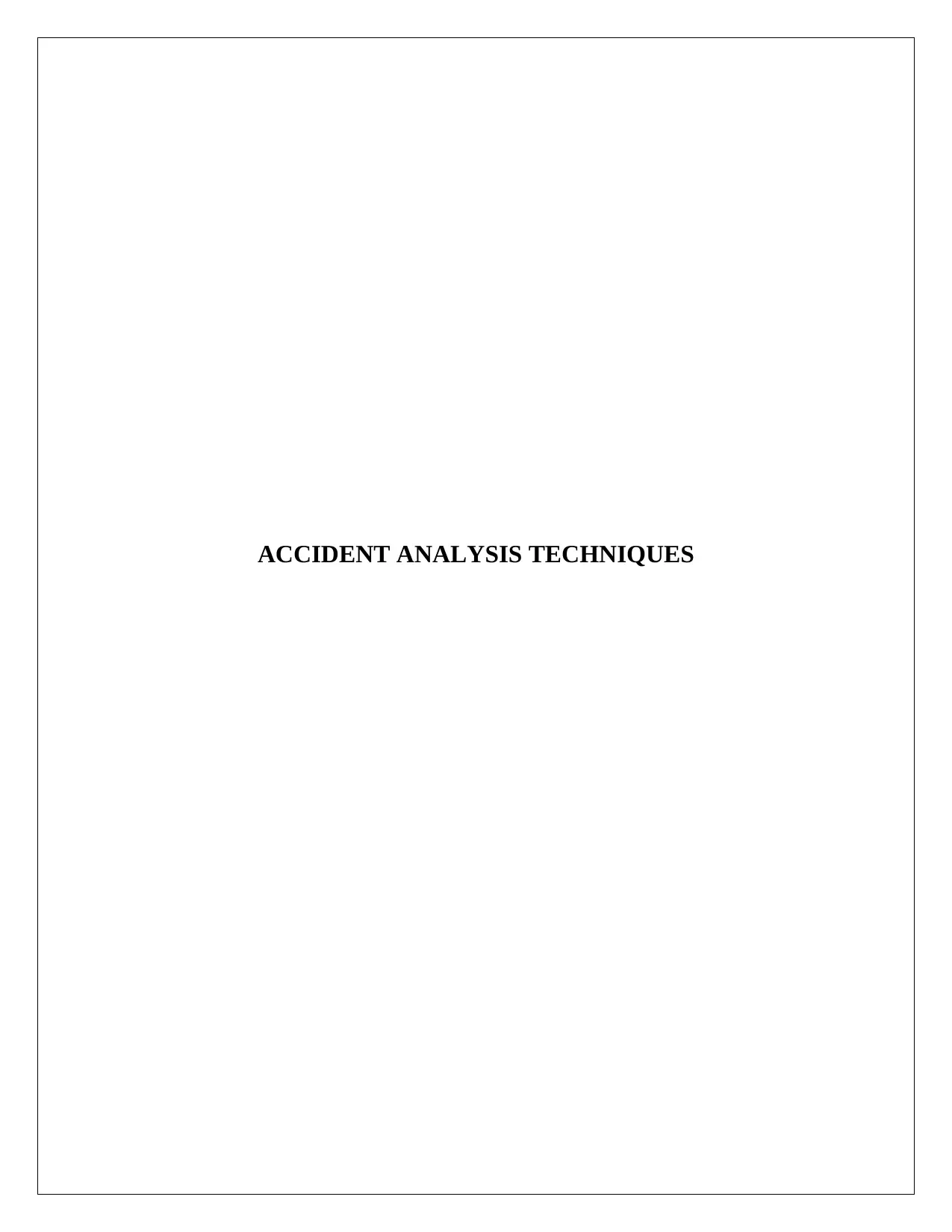
ACCIDENT ANALYSIS TECHNIQUES
Paraphrase This Document
Need a fresh take? Get an instant paraphrase of this document with our AI Paraphraser
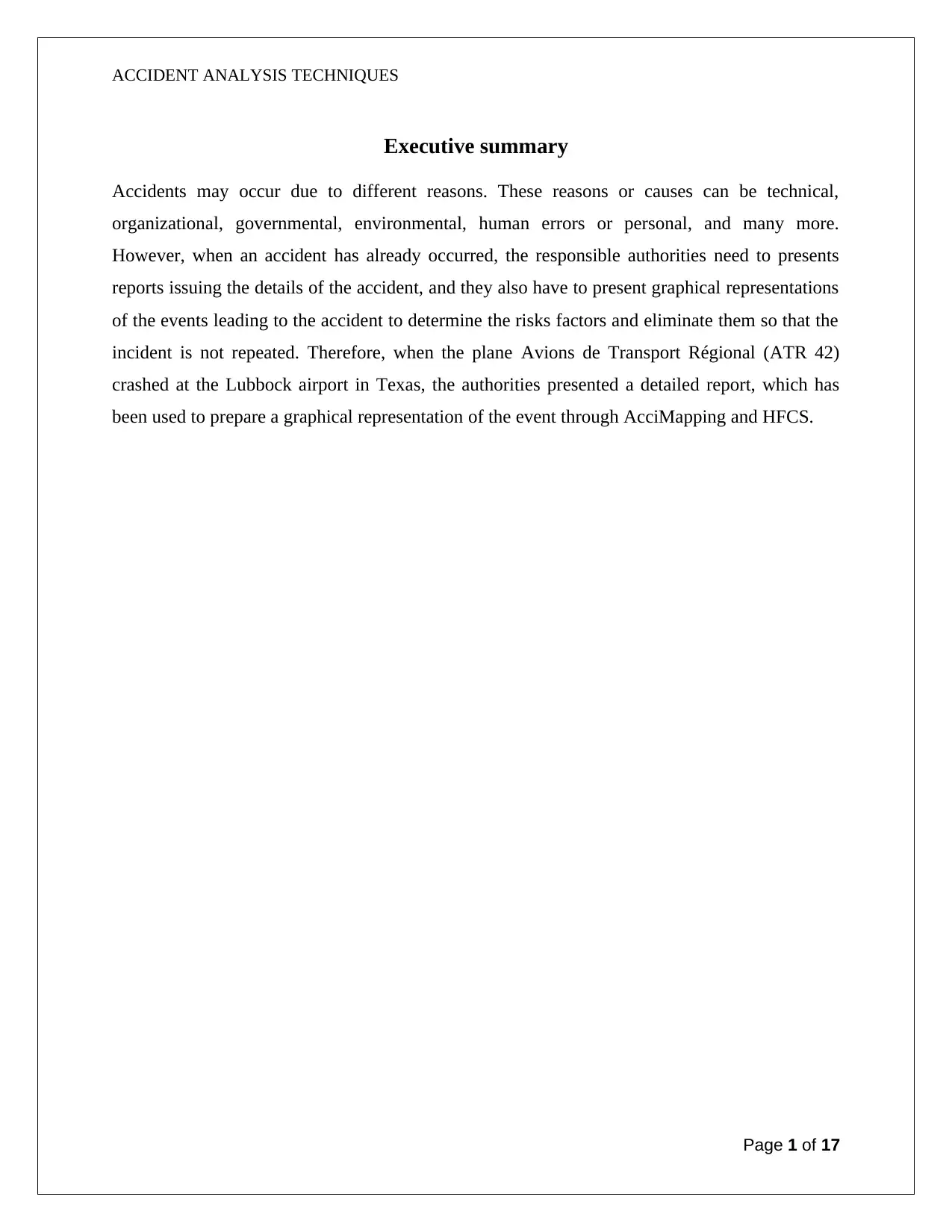
ACCIDENT ANALYSIS TECHNIQUES
Executive summary
Accidents may occur due to different reasons. These reasons or causes can be technical,
organizational, governmental, environmental, human errors or personal, and many more.
However, when an accident has already occurred, the responsible authorities need to presents
reports issuing the details of the accident, and they also have to present graphical representations
of the events leading to the accident to determine the risks factors and eliminate them so that the
incident is not repeated. Therefore, when the plane Avions de Transport Régional (ATR 42)
crashed at the Lubbock airport in Texas, the authorities presented a detailed report, which has
been used to prepare a graphical representation of the event through AcciMapping and HFCS.
Page 1 of 17
Executive summary
Accidents may occur due to different reasons. These reasons or causes can be technical,
organizational, governmental, environmental, human errors or personal, and many more.
However, when an accident has already occurred, the responsible authorities need to presents
reports issuing the details of the accident, and they also have to present graphical representations
of the events leading to the accident to determine the risks factors and eliminate them so that the
incident is not repeated. Therefore, when the plane Avions de Transport Régional (ATR 42)
crashed at the Lubbock airport in Texas, the authorities presented a detailed report, which has
been used to prepare a graphical representation of the event through AcciMapping and HFCS.
Page 1 of 17
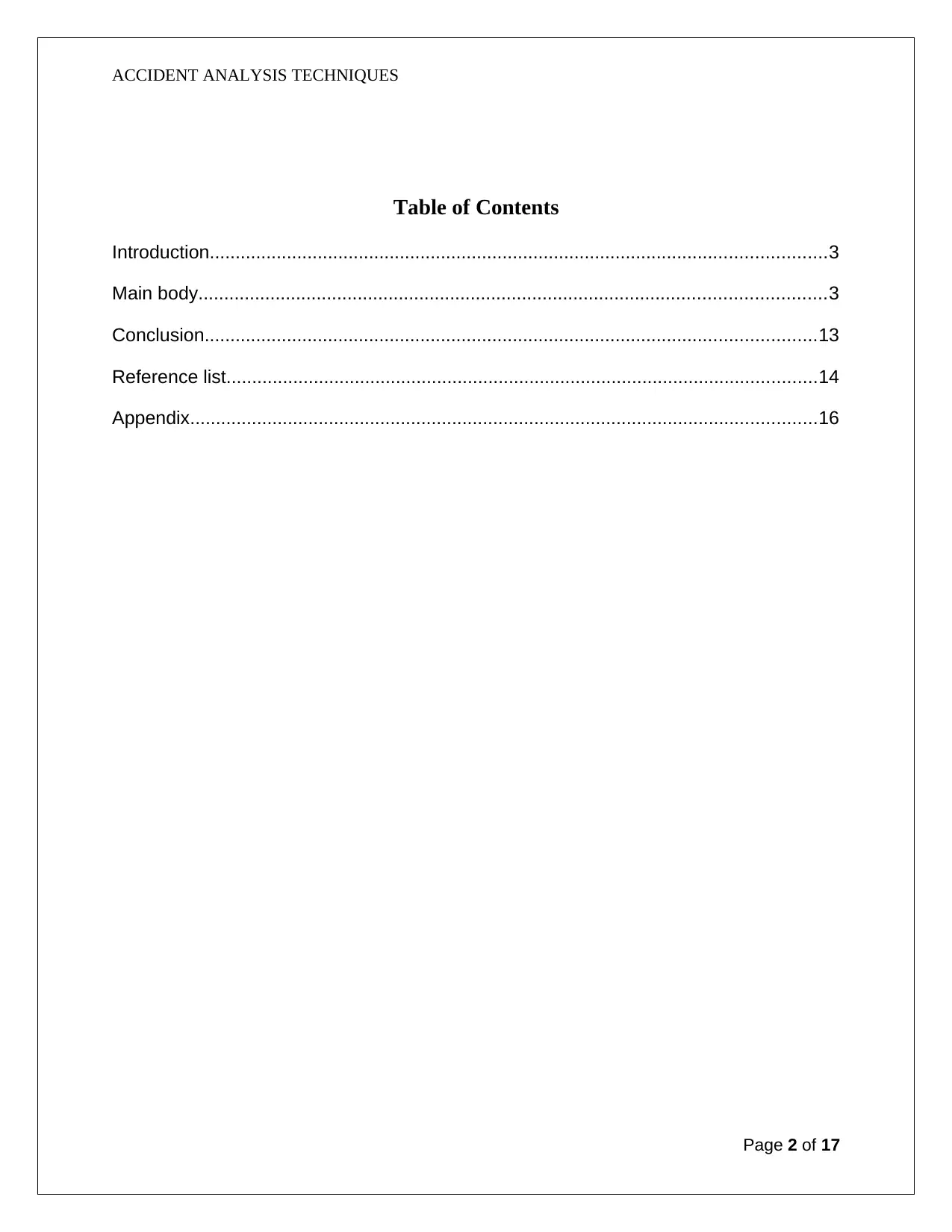
ACCIDENT ANALYSIS TECHNIQUES
Table of Contents
Introduction........................................................................................................................3
Main body..........................................................................................................................3
Conclusion.......................................................................................................................13
Reference list...................................................................................................................14
Appendix..........................................................................................................................16
Page 2 of 17
Table of Contents
Introduction........................................................................................................................3
Main body..........................................................................................................................3
Conclusion.......................................................................................................................13
Reference list...................................................................................................................14
Appendix..........................................................................................................................16
Page 2 of 17
⊘ This is a preview!⊘
Do you want full access?
Subscribe today to unlock all pages.

Trusted by 1+ million students worldwide
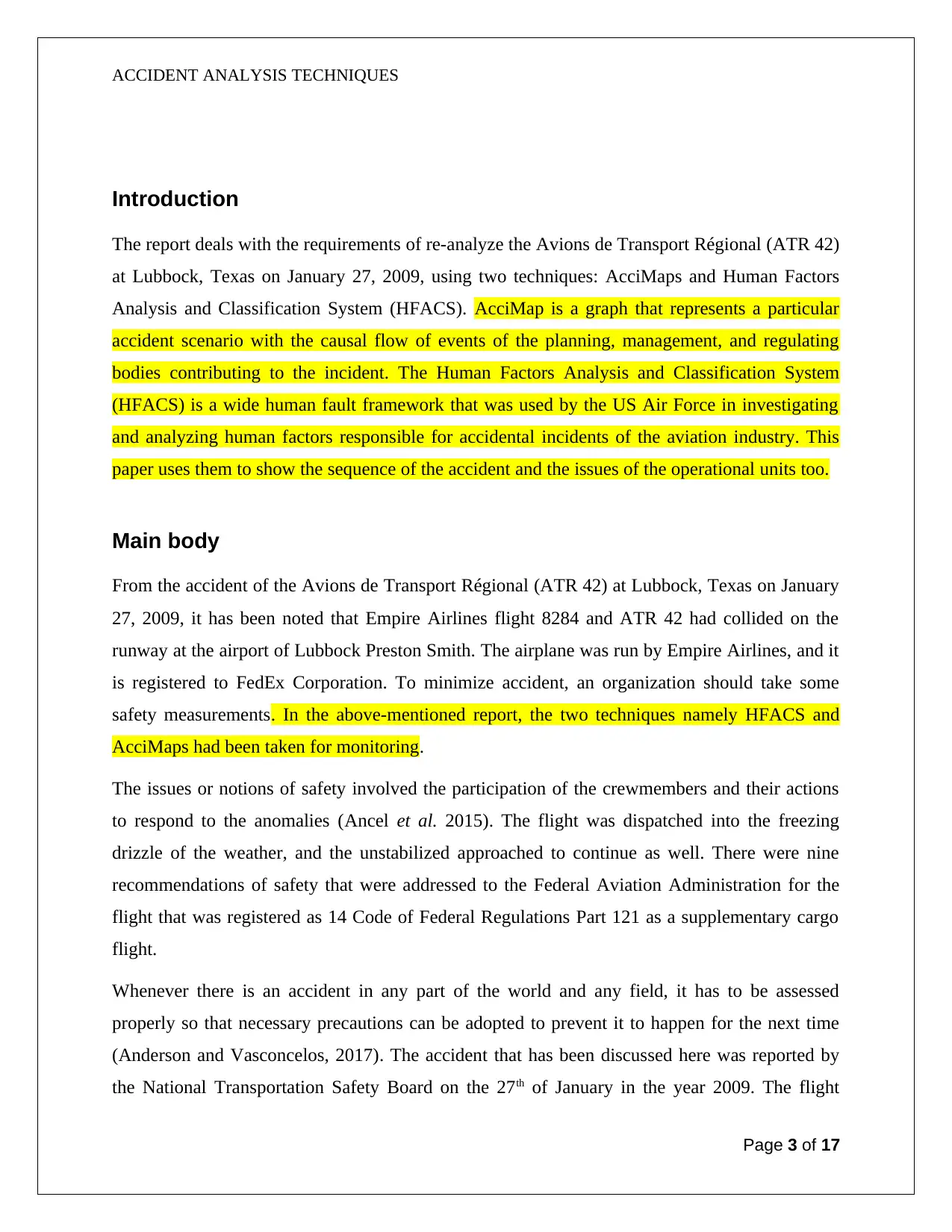
ACCIDENT ANALYSIS TECHNIQUES
Introduction
The report deals with the requirements of re-analyze the Avions de Transport Régional (ATR 42)
at Lubbock, Texas on January 27, 2009, using two techniques: AcciMaps and Human Factors
Analysis and Classification System (HFACS). AcciMap is a graph that represents a particular
accident scenario with the causal flow of events of the planning, management, and regulating
bodies contributing to the incident. The Human Factors Analysis and Classification System
(HFACS) is a wide human fault framework that was used by the US Air Force in investigating
and analyzing human factors responsible for accidental incidents of the aviation industry. This
paper uses them to show the sequence of the accident and the issues of the operational units too.
Main body
From the accident of the Avions de Transport Régional (ATR 42) at Lubbock, Texas on January
27, 2009, it has been noted that Empire Airlines flight 8284 and ATR 42 had collided on the
runway at the airport of Lubbock Preston Smith. The airplane was run by Empire Airlines, and it
is registered to FedEx Corporation. To minimize accident, an organization should take some
safety measurements. In the above-mentioned report, the two techniques namely HFACS and
AcciMaps had been taken for monitoring.
The issues or notions of safety involved the participation of the crewmembers and their actions
to respond to the anomalies (Ancel et al. 2015). The flight was dispatched into the freezing
drizzle of the weather, and the unstabilized approached to continue as well. There were nine
recommendations of safety that were addressed to the Federal Aviation Administration for the
flight that was registered as 14 Code of Federal Regulations Part 121 as a supplementary cargo
flight.
Whenever there is an accident in any part of the world and any field, it has to be assessed
properly so that necessary precautions can be adopted to prevent it to happen for the next time
(Anderson and Vasconcelos, 2017). The accident that has been discussed here was reported by
the National Transportation Safety Board on the 27th of January in the year 2009. The flight
Page 3 of 17
Introduction
The report deals with the requirements of re-analyze the Avions de Transport Régional (ATR 42)
at Lubbock, Texas on January 27, 2009, using two techniques: AcciMaps and Human Factors
Analysis and Classification System (HFACS). AcciMap is a graph that represents a particular
accident scenario with the causal flow of events of the planning, management, and regulating
bodies contributing to the incident. The Human Factors Analysis and Classification System
(HFACS) is a wide human fault framework that was used by the US Air Force in investigating
and analyzing human factors responsible for accidental incidents of the aviation industry. This
paper uses them to show the sequence of the accident and the issues of the operational units too.
Main body
From the accident of the Avions de Transport Régional (ATR 42) at Lubbock, Texas on January
27, 2009, it has been noted that Empire Airlines flight 8284 and ATR 42 had collided on the
runway at the airport of Lubbock Preston Smith. The airplane was run by Empire Airlines, and it
is registered to FedEx Corporation. To minimize accident, an organization should take some
safety measurements. In the above-mentioned report, the two techniques namely HFACS and
AcciMaps had been taken for monitoring.
The issues or notions of safety involved the participation of the crewmembers and their actions
to respond to the anomalies (Ancel et al. 2015). The flight was dispatched into the freezing
drizzle of the weather, and the unstabilized approached to continue as well. There were nine
recommendations of safety that were addressed to the Federal Aviation Administration for the
flight that was registered as 14 Code of Federal Regulations Part 121 as a supplementary cargo
flight.
Whenever there is an accident in any part of the world and any field, it has to be assessed
properly so that necessary precautions can be adopted to prevent it to happen for the next time
(Anderson and Vasconcelos, 2017). The accident that has been discussed here was reported by
the National Transportation Safety Board on the 27th of January in the year 2009. The flight
Page 3 of 17
Paraphrase This Document
Need a fresh take? Get an instant paraphrase of this document with our AI Paraphraser
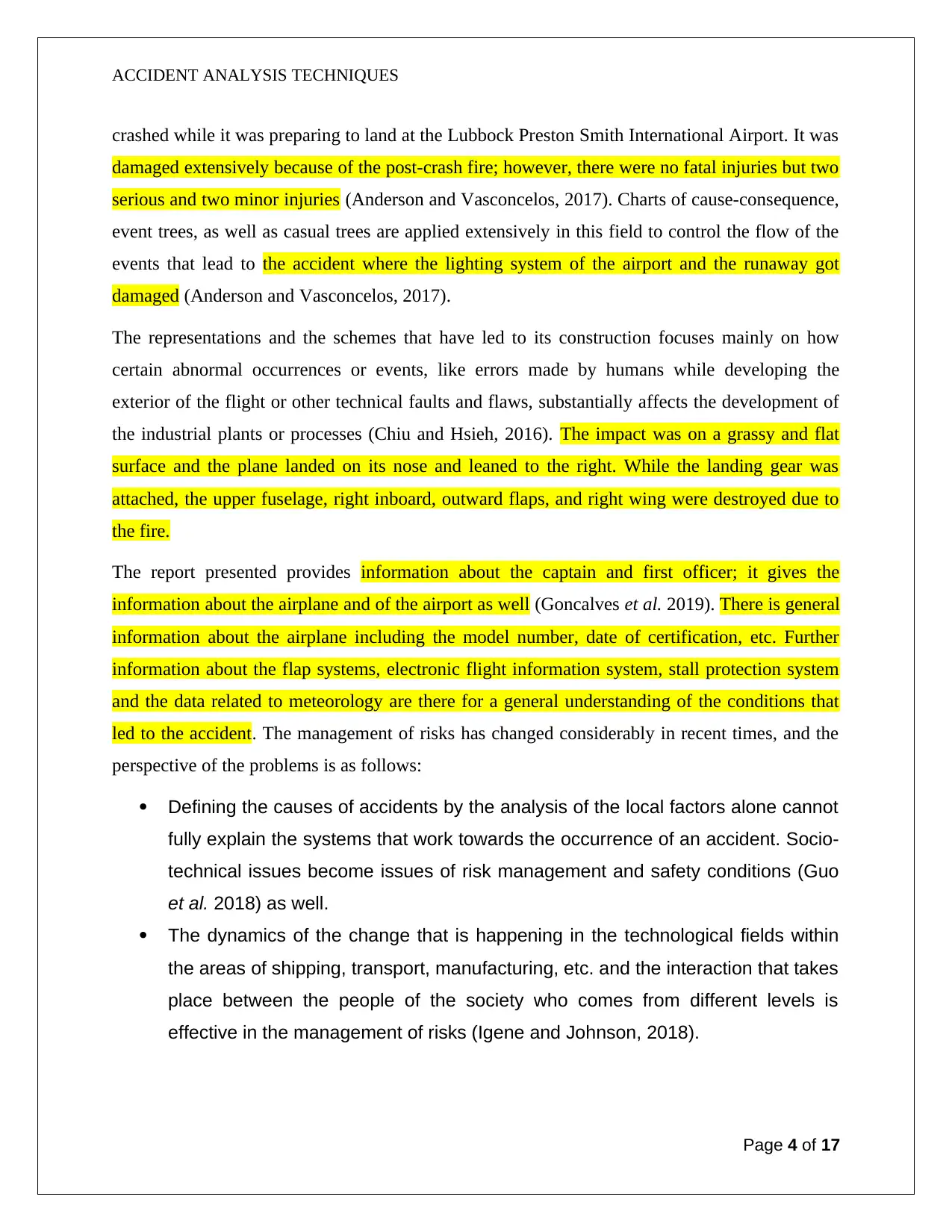
ACCIDENT ANALYSIS TECHNIQUES
crashed while it was preparing to land at the Lubbock Preston Smith International Airport. It was
damaged extensively because of the post-crash fire; however, there were no fatal injuries but two
serious and two minor injuries (Anderson and Vasconcelos, 2017). Charts of cause-consequence,
event trees, as well as casual trees are applied extensively in this field to control the flow of the
events that lead to the accident where the lighting system of the airport and the runaway got
damaged (Anderson and Vasconcelos, 2017).
The representations and the schemes that have led to its construction focuses mainly on how
certain abnormal occurrences or events, like errors made by humans while developing the
exterior of the flight or other technical faults and flaws, substantially affects the development of
the industrial plants or processes (Chiu and Hsieh, 2016). The impact was on a grassy and flat
surface and the plane landed on its nose and leaned to the right. While the landing gear was
attached, the upper fuselage, right inboard, outward flaps, and right wing were destroyed due to
the fire.
The report presented provides information about the captain and first officer; it gives the
information about the airplane and of the airport as well (Goncalves et al. 2019). There is general
information about the airplane including the model number, date of certification, etc. Further
information about the flap systems, electronic flight information system, stall protection system
and the data related to meteorology are there for a general understanding of the conditions that
led to the accident. The management of risks has changed considerably in recent times, and the
perspective of the problems is as follows:
Defining the causes of accidents by the analysis of the local factors alone cannot
fully explain the systems that work towards the occurrence of an accident. Socio-
technical issues become issues of risk management and safety conditions (Guo
et al. 2018) as well.
The dynamics of the change that is happening in the technological fields within
the areas of shipping, transport, manufacturing, etc. and the interaction that takes
place between the people of the society who comes from different levels is
effective in the management of risks (Igene and Johnson, 2018).
Page 4 of 17
crashed while it was preparing to land at the Lubbock Preston Smith International Airport. It was
damaged extensively because of the post-crash fire; however, there were no fatal injuries but two
serious and two minor injuries (Anderson and Vasconcelos, 2017). Charts of cause-consequence,
event trees, as well as casual trees are applied extensively in this field to control the flow of the
events that lead to the accident where the lighting system of the airport and the runaway got
damaged (Anderson and Vasconcelos, 2017).
The representations and the schemes that have led to its construction focuses mainly on how
certain abnormal occurrences or events, like errors made by humans while developing the
exterior of the flight or other technical faults and flaws, substantially affects the development of
the industrial plants or processes (Chiu and Hsieh, 2016). The impact was on a grassy and flat
surface and the plane landed on its nose and leaned to the right. While the landing gear was
attached, the upper fuselage, right inboard, outward flaps, and right wing were destroyed due to
the fire.
The report presented provides information about the captain and first officer; it gives the
information about the airplane and of the airport as well (Goncalves et al. 2019). There is general
information about the airplane including the model number, date of certification, etc. Further
information about the flap systems, electronic flight information system, stall protection system
and the data related to meteorology are there for a general understanding of the conditions that
led to the accident. The management of risks has changed considerably in recent times, and the
perspective of the problems is as follows:
Defining the causes of accidents by the analysis of the local factors alone cannot
fully explain the systems that work towards the occurrence of an accident. Socio-
technical issues become issues of risk management and safety conditions (Guo
et al. 2018) as well.
The dynamics of the change that is happening in the technological fields within
the areas of shipping, transport, manufacturing, etc. and the interaction that takes
place between the people of the society who comes from different levels is
effective in the management of risks (Igene and Johnson, 2018).
Page 4 of 17
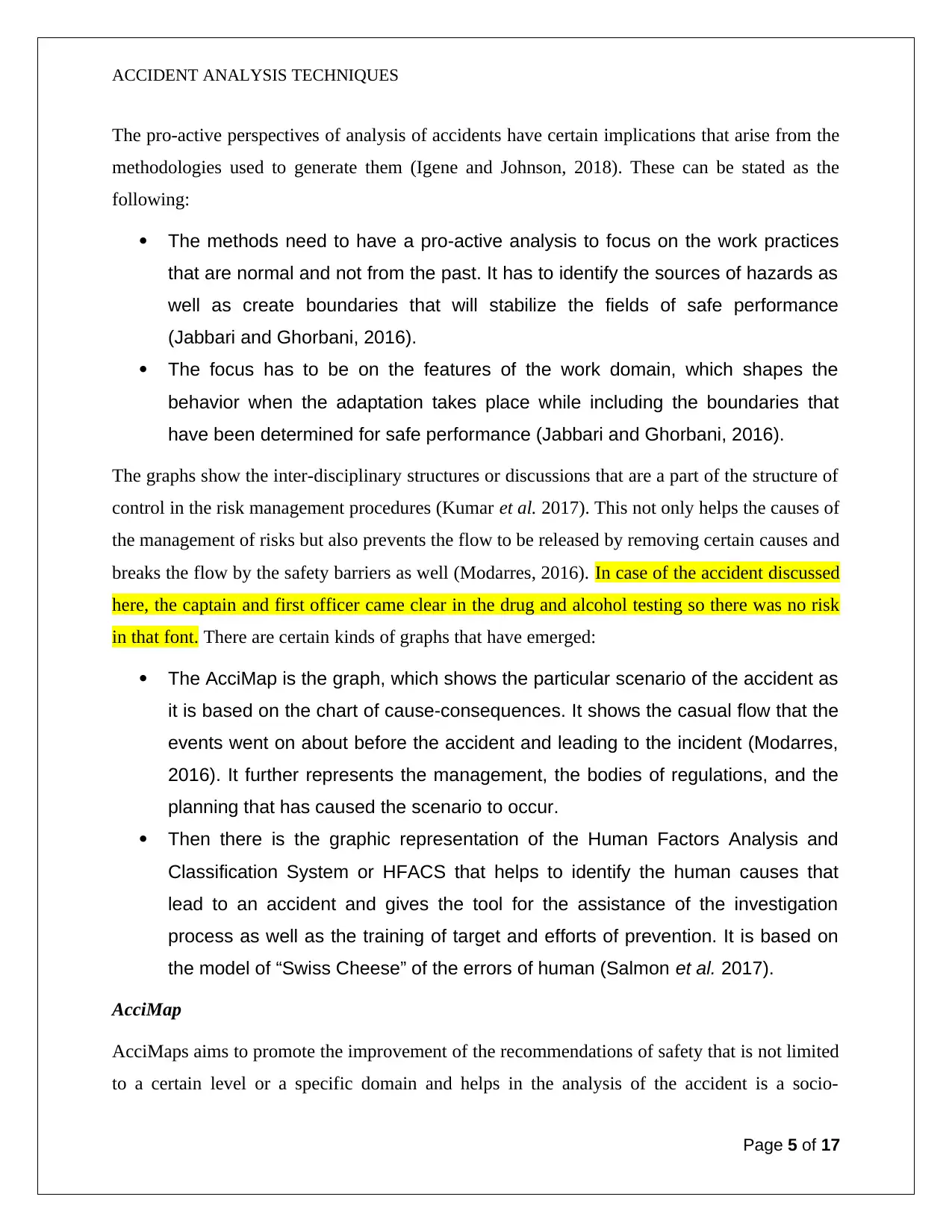
ACCIDENT ANALYSIS TECHNIQUES
The pro-active perspectives of analysis of accidents have certain implications that arise from the
methodologies used to generate them (Igene and Johnson, 2018). These can be stated as the
following:
The methods need to have a pro-active analysis to focus on the work practices
that are normal and not from the past. It has to identify the sources of hazards as
well as create boundaries that will stabilize the fields of safe performance
(Jabbari and Ghorbani, 2016).
The focus has to be on the features of the work domain, which shapes the
behavior when the adaptation takes place while including the boundaries that
have been determined for safe performance (Jabbari and Ghorbani, 2016).
The graphs show the inter-disciplinary structures or discussions that are a part of the structure of
control in the risk management procedures (Kumar et al. 2017). This not only helps the causes of
the management of risks but also prevents the flow to be released by removing certain causes and
breaks the flow by the safety barriers as well (Modarres, 2016). In case of the accident discussed
here, the captain and first officer came clear in the drug and alcohol testing so there was no risk
in that font. There are certain kinds of graphs that have emerged:
The AcciMap is the graph, which shows the particular scenario of the accident as
it is based on the chart of cause-consequences. It shows the casual flow that the
events went on about before the accident and leading to the incident (Modarres,
2016). It further represents the management, the bodies of regulations, and the
planning that has caused the scenario to occur.
Then there is the graphic representation of the Human Factors Analysis and
Classification System or HFACS that helps to identify the human causes that
lead to an accident and gives the tool for the assistance of the investigation
process as well as the training of target and efforts of prevention. It is based on
the model of “Swiss Cheese” of the errors of human (Salmon et al. 2017).
AcciMap
AcciMaps aims to promote the improvement of the recommendations of safety that is not limited
to a certain level or a specific domain and helps in the analysis of the accident is a socio-
Page 5 of 17
The pro-active perspectives of analysis of accidents have certain implications that arise from the
methodologies used to generate them (Igene and Johnson, 2018). These can be stated as the
following:
The methods need to have a pro-active analysis to focus on the work practices
that are normal and not from the past. It has to identify the sources of hazards as
well as create boundaries that will stabilize the fields of safe performance
(Jabbari and Ghorbani, 2016).
The focus has to be on the features of the work domain, which shapes the
behavior when the adaptation takes place while including the boundaries that
have been determined for safe performance (Jabbari and Ghorbani, 2016).
The graphs show the inter-disciplinary structures or discussions that are a part of the structure of
control in the risk management procedures (Kumar et al. 2017). This not only helps the causes of
the management of risks but also prevents the flow to be released by removing certain causes and
breaks the flow by the safety barriers as well (Modarres, 2016). In case of the accident discussed
here, the captain and first officer came clear in the drug and alcohol testing so there was no risk
in that font. There are certain kinds of graphs that have emerged:
The AcciMap is the graph, which shows the particular scenario of the accident as
it is based on the chart of cause-consequences. It shows the casual flow that the
events went on about before the accident and leading to the incident (Modarres,
2016). It further represents the management, the bodies of regulations, and the
planning that has caused the scenario to occur.
Then there is the graphic representation of the Human Factors Analysis and
Classification System or HFACS that helps to identify the human causes that
lead to an accident and gives the tool for the assistance of the investigation
process as well as the training of target and efforts of prevention. It is based on
the model of “Swiss Cheese” of the errors of human (Salmon et al. 2017).
AcciMap
AcciMaps aims to promote the improvement of the recommendations of safety that is not limited
to a certain level or a specific domain and helps in the analysis of the accident is a socio-
Page 5 of 17
⊘ This is a preview!⊘
Do you want full access?
Subscribe today to unlock all pages.

Trusted by 1+ million students worldwide
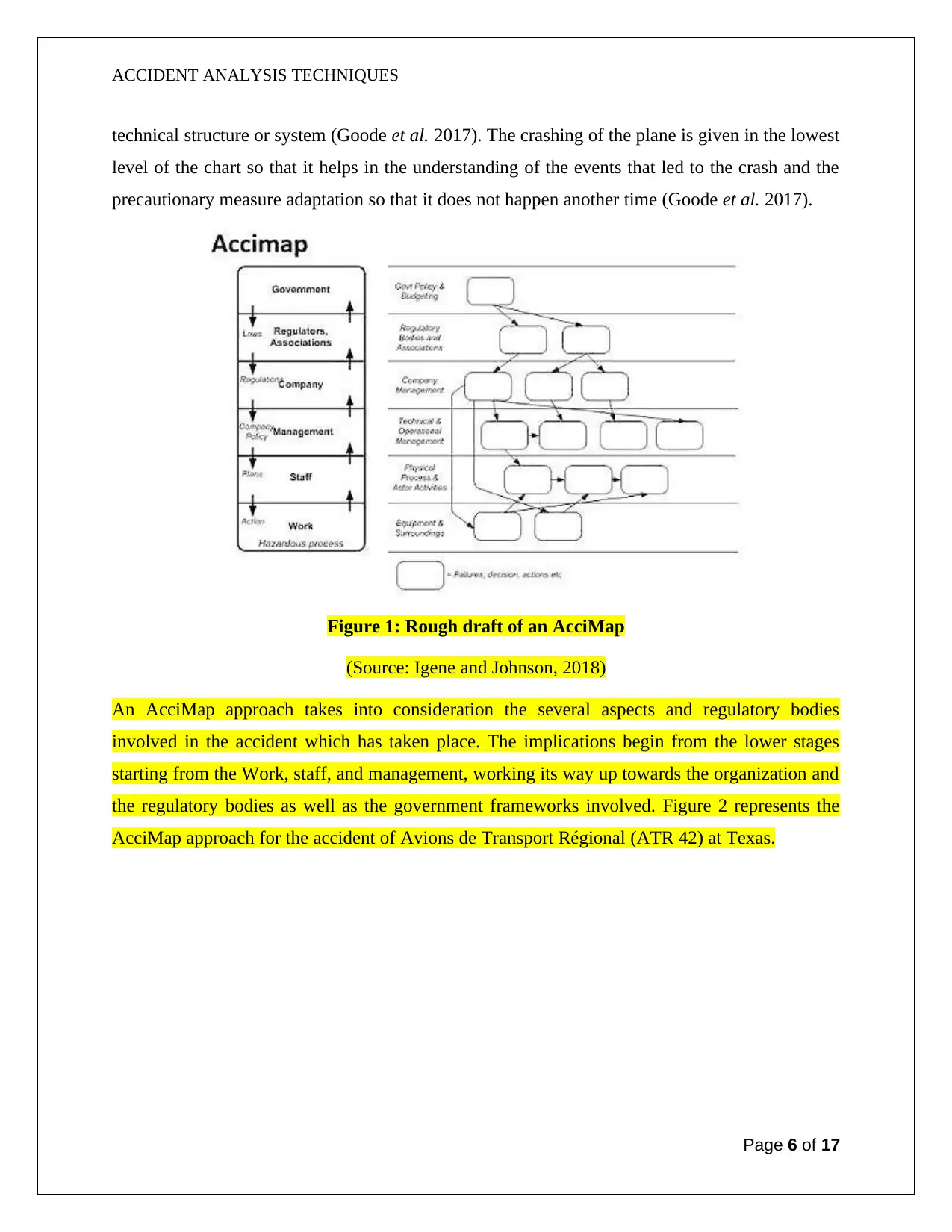
ACCIDENT ANALYSIS TECHNIQUES
technical structure or system (Goode et al. 2017). The crashing of the plane is given in the lowest
level of the chart so that it helps in the understanding of the events that led to the crash and the
precautionary measure adaptation so that it does not happen another time (Goode et al. 2017).
Figure 1: Rough draft of an AcciMap
(Source: Igene and Johnson, 2018)
An AcciMap approach takes into consideration the several aspects and regulatory bodies
involved in the accident which has taken place. The implications begin from the lower stages
starting from the Work, staff, and management, working its way up towards the organization and
the regulatory bodies as well as the government frameworks involved. Figure 2 represents the
AcciMap approach for the accident of Avions de Transport Régional (ATR 42) at Texas.
Page 6 of 17
technical structure or system (Goode et al. 2017). The crashing of the plane is given in the lowest
level of the chart so that it helps in the understanding of the events that led to the crash and the
precautionary measure adaptation so that it does not happen another time (Goode et al. 2017).
Figure 1: Rough draft of an AcciMap
(Source: Igene and Johnson, 2018)
An AcciMap approach takes into consideration the several aspects and regulatory bodies
involved in the accident which has taken place. The implications begin from the lower stages
starting from the Work, staff, and management, working its way up towards the organization and
the regulatory bodies as well as the government frameworks involved. Figure 2 represents the
AcciMap approach for the accident of Avions de Transport Régional (ATR 42) at Texas.
Page 6 of 17
Paraphrase This Document
Need a fresh take? Get an instant paraphrase of this document with our AI Paraphraser
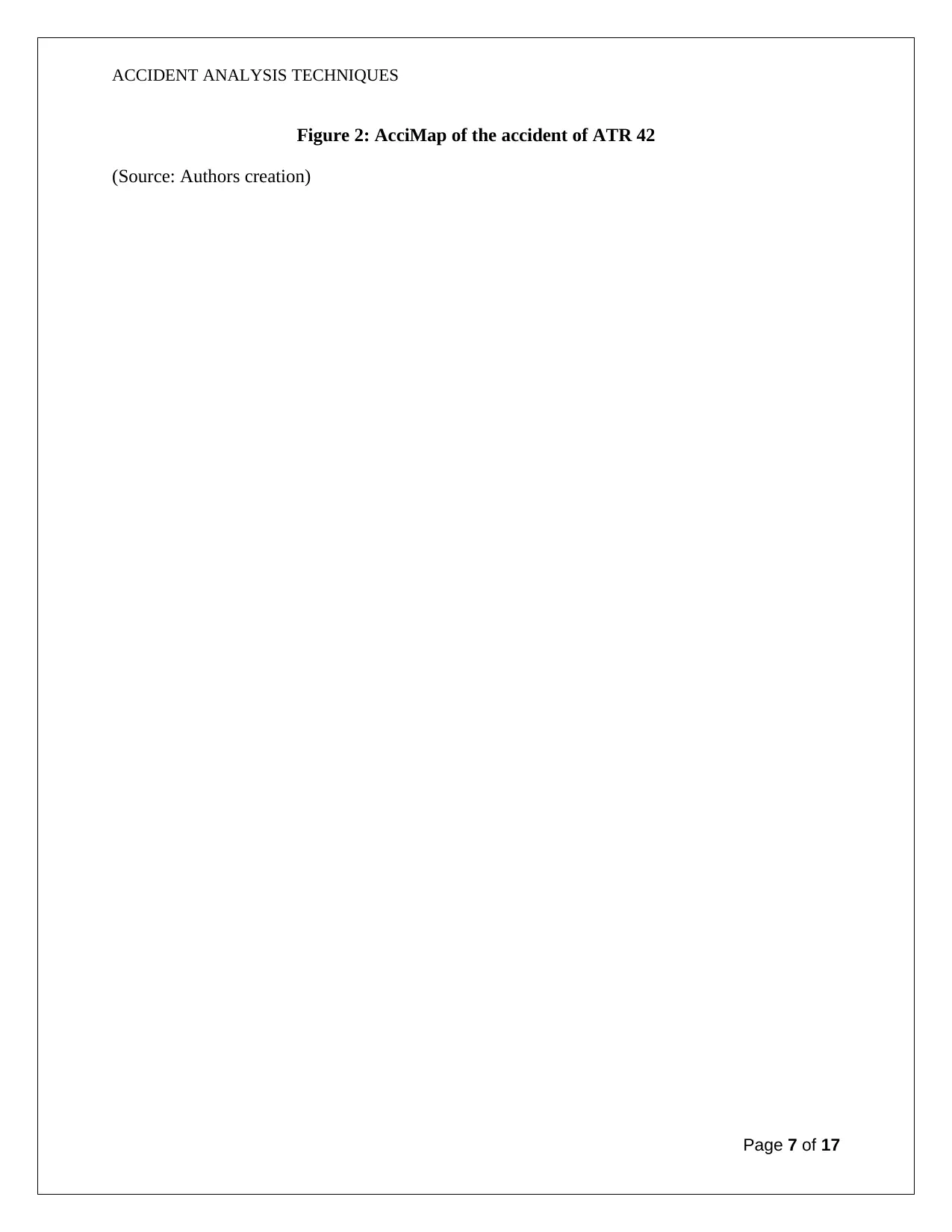
ACCIDENT ANALYSIS TECHNIQUES
Figure 2: AcciMap of the accident of ATR 42
(Source: Authors creation)
Page 7 of 17
Figure 2: AcciMap of the accident of ATR 42
(Source: Authors creation)
Page 7 of 17
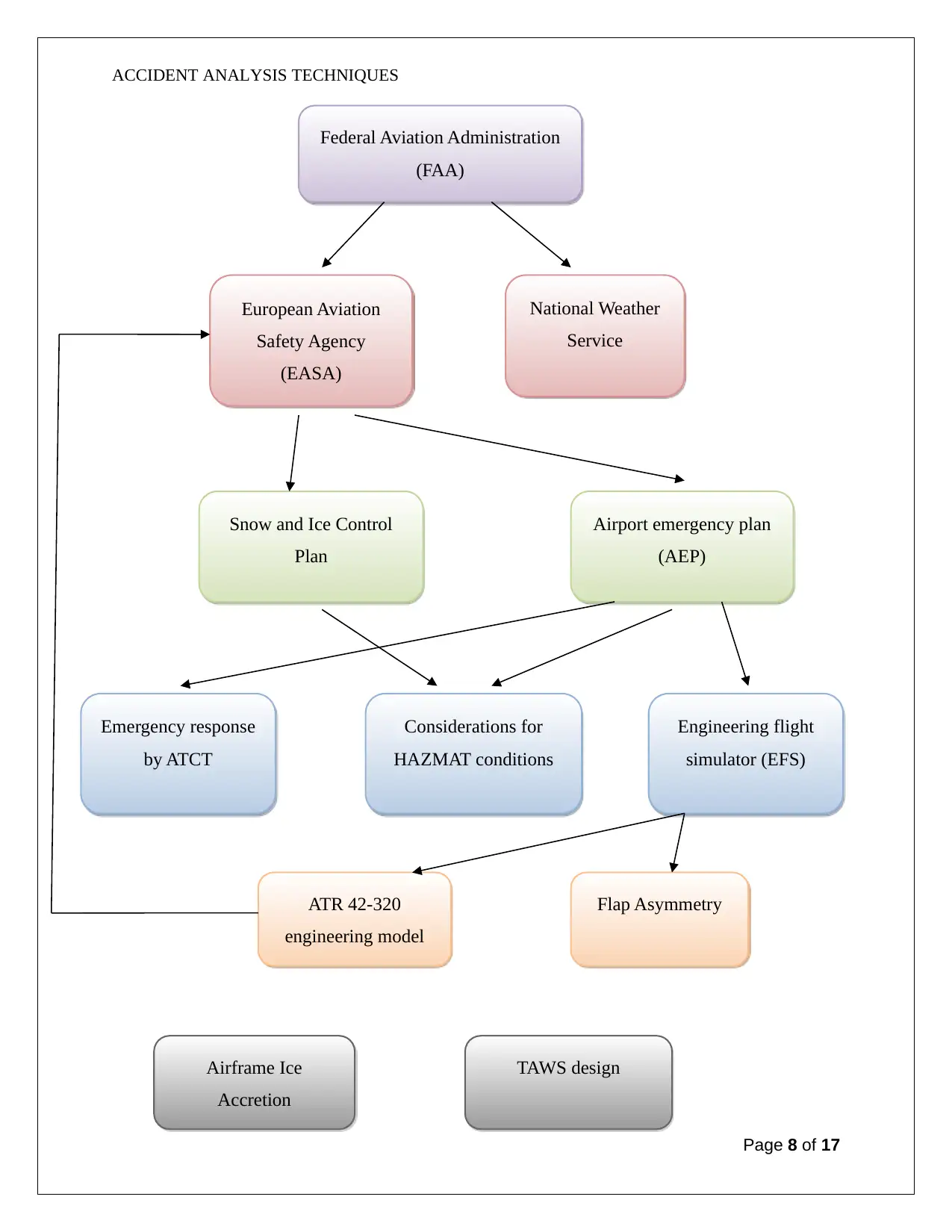
ACCIDENT ANALYSIS TECHNIQUES
Page 8 of 17
Federal Aviation Administration
(FAA)
European Aviation
Safety Agency
(EASA)
Snow and Ice Control
Plan
Airport emergency plan
(AEP)
National Weather
Service
Emergency response
by ATCT
Considerations for
HAZMAT conditions
Engineering flight
simulator (EFS)
ATR 42-320
engineering model
Flap Asymmetry
Airframe Ice
Accretion
TAWS design
Page 8 of 17
Federal Aviation Administration
(FAA)
European Aviation
Safety Agency
(EASA)
Snow and Ice Control
Plan
Airport emergency plan
(AEP)
National Weather
Service
Emergency response
by ATCT
Considerations for
HAZMAT conditions
Engineering flight
simulator (EFS)
ATR 42-320
engineering model
Flap Asymmetry
Airframe Ice
Accretion
TAWS design
⊘ This is a preview!⊘
Do you want full access?
Subscribe today to unlock all pages.

Trusted by 1+ million students worldwide
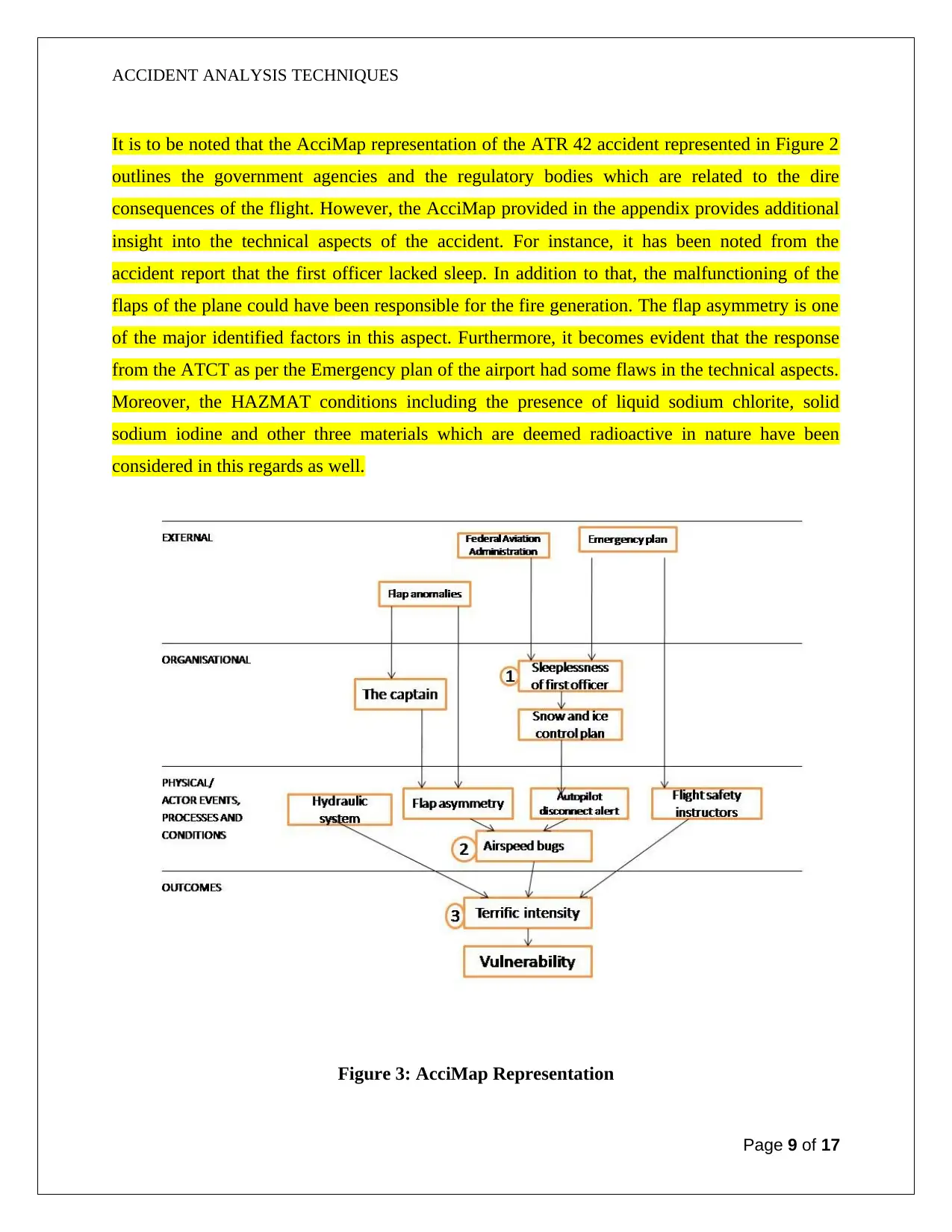
ACCIDENT ANALYSIS TECHNIQUES
It is to be noted that the AcciMap representation of the ATR 42 accident represented in Figure 2
outlines the government agencies and the regulatory bodies which are related to the dire
consequences of the flight. However, the AcciMap provided in the appendix provides additional
insight into the technical aspects of the accident. For instance, it has been noted from the
accident report that the first officer lacked sleep. In addition to that, the malfunctioning of the
flaps of the plane could have been responsible for the fire generation. The flap asymmetry is one
of the major identified factors in this aspect. Furthermore, it becomes evident that the response
from the ATCT as per the Emergency plan of the airport had some flaws in the technical aspects.
Moreover, the HAZMAT conditions including the presence of liquid sodium chlorite, solid
sodium iodine and other three materials which are deemed radioactive in nature have been
considered in this regards as well.
Figure 3: AcciMap Representation
Page 9 of 17
It is to be noted that the AcciMap representation of the ATR 42 accident represented in Figure 2
outlines the government agencies and the regulatory bodies which are related to the dire
consequences of the flight. However, the AcciMap provided in the appendix provides additional
insight into the technical aspects of the accident. For instance, it has been noted from the
accident report that the first officer lacked sleep. In addition to that, the malfunctioning of the
flaps of the plane could have been responsible for the fire generation. The flap asymmetry is one
of the major identified factors in this aspect. Furthermore, it becomes evident that the response
from the ATCT as per the Emergency plan of the airport had some flaws in the technical aspects.
Moreover, the HAZMAT conditions including the presence of liquid sodium chlorite, solid
sodium iodine and other three materials which are deemed radioactive in nature have been
considered in this regards as well.
Figure 3: AcciMap Representation
Page 9 of 17
Paraphrase This Document
Need a fresh take? Get an instant paraphrase of this document with our AI Paraphraser
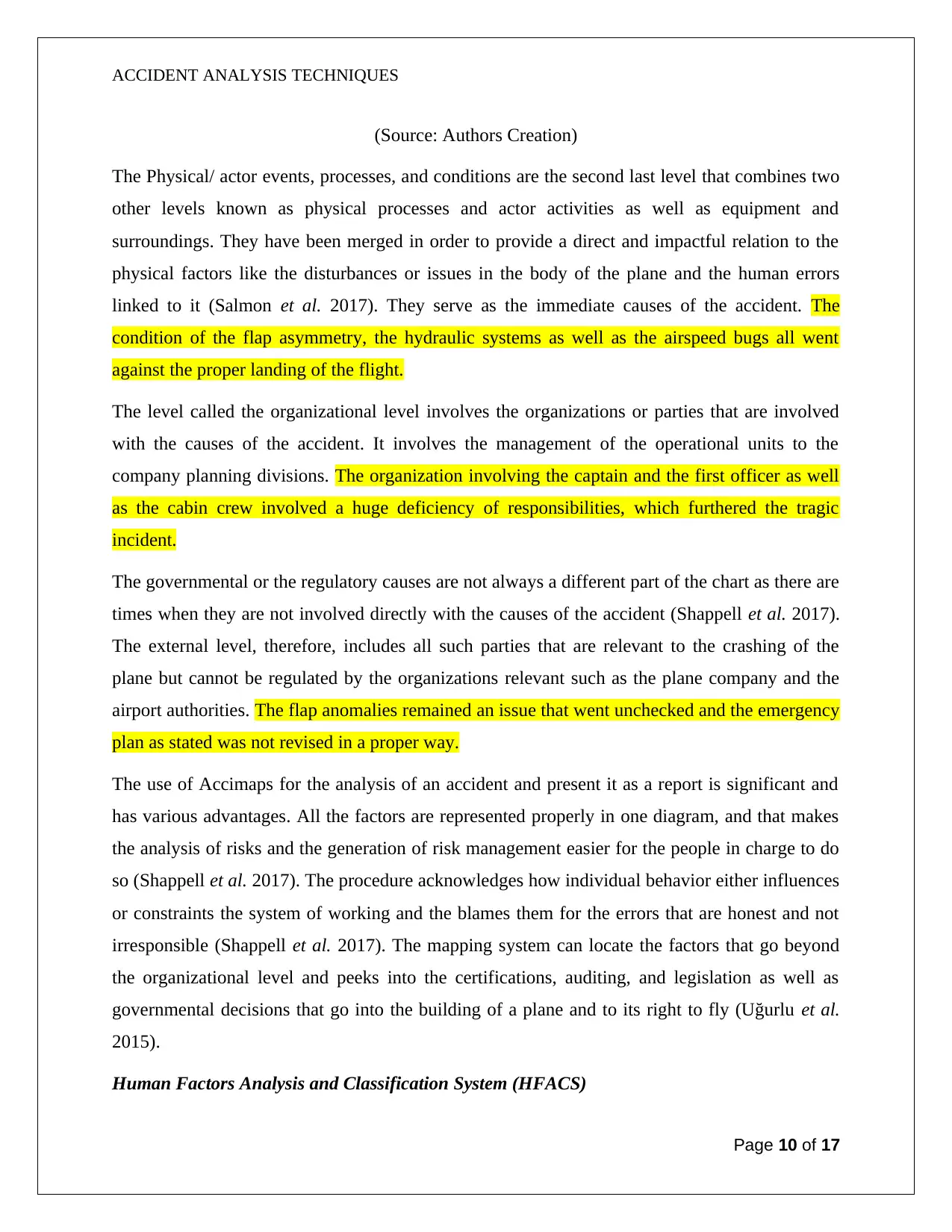
ACCIDENT ANALYSIS TECHNIQUES
(Source: Authors Creation)
The Physical/ actor events, processes, and conditions are the second last level that combines two
other levels known as physical processes and actor activities as well as equipment and
surroundings. They have been merged in order to provide a direct and impactful relation to the
physical factors like the disturbances or issues in the body of the plane and the human errors
linked to it (Salmon et al. 2017). They serve as the immediate causes of the accident. The
condition of the flap asymmetry, the hydraulic systems as well as the airspeed bugs all went
against the proper landing of the flight.
The level called the organizational level involves the organizations or parties that are involved
with the causes of the accident. It involves the management of the operational units to the
company planning divisions. The organization involving the captain and the first officer as well
as the cabin crew involved a huge deficiency of responsibilities, which furthered the tragic
incident.
The governmental or the regulatory causes are not always a different part of the chart as there are
times when they are not involved directly with the causes of the accident (Shappell et al. 2017).
The external level, therefore, includes all such parties that are relevant to the crashing of the
plane but cannot be regulated by the organizations relevant such as the plane company and the
airport authorities. The flap anomalies remained an issue that went unchecked and the emergency
plan as stated was not revised in a proper way.
The use of Accimaps for the analysis of an accident and present it as a report is significant and
has various advantages. All the factors are represented properly in one diagram, and that makes
the analysis of risks and the generation of risk management easier for the people in charge to do
so (Shappell et al. 2017). The procedure acknowledges how individual behavior either influences
or constraints the system of working and the blames them for the errors that are honest and not
irresponsible (Shappell et al. 2017). The mapping system can locate the factors that go beyond
the organizational level and peeks into the certifications, auditing, and legislation as well as
governmental decisions that go into the building of a plane and to its right to fly (Uğurlu et al.
2015).
Human Factors Analysis and Classification System (HFACS)
Page 10 of 17
(Source: Authors Creation)
The Physical/ actor events, processes, and conditions are the second last level that combines two
other levels known as physical processes and actor activities as well as equipment and
surroundings. They have been merged in order to provide a direct and impactful relation to the
physical factors like the disturbances or issues in the body of the plane and the human errors
linked to it (Salmon et al. 2017). They serve as the immediate causes of the accident. The
condition of the flap asymmetry, the hydraulic systems as well as the airspeed bugs all went
against the proper landing of the flight.
The level called the organizational level involves the organizations or parties that are involved
with the causes of the accident. It involves the management of the operational units to the
company planning divisions. The organization involving the captain and the first officer as well
as the cabin crew involved a huge deficiency of responsibilities, which furthered the tragic
incident.
The governmental or the regulatory causes are not always a different part of the chart as there are
times when they are not involved directly with the causes of the accident (Shappell et al. 2017).
The external level, therefore, includes all such parties that are relevant to the crashing of the
plane but cannot be regulated by the organizations relevant such as the plane company and the
airport authorities. The flap anomalies remained an issue that went unchecked and the emergency
plan as stated was not revised in a proper way.
The use of Accimaps for the analysis of an accident and present it as a report is significant and
has various advantages. All the factors are represented properly in one diagram, and that makes
the analysis of risks and the generation of risk management easier for the people in charge to do
so (Shappell et al. 2017). The procedure acknowledges how individual behavior either influences
or constraints the system of working and the blames them for the errors that are honest and not
irresponsible (Shappell et al. 2017). The mapping system can locate the factors that go beyond
the organizational level and peeks into the certifications, auditing, and legislation as well as
governmental decisions that go into the building of a plane and to its right to fly (Uğurlu et al.
2015).
Human Factors Analysis and Classification System (HFACS)
Page 10 of 17
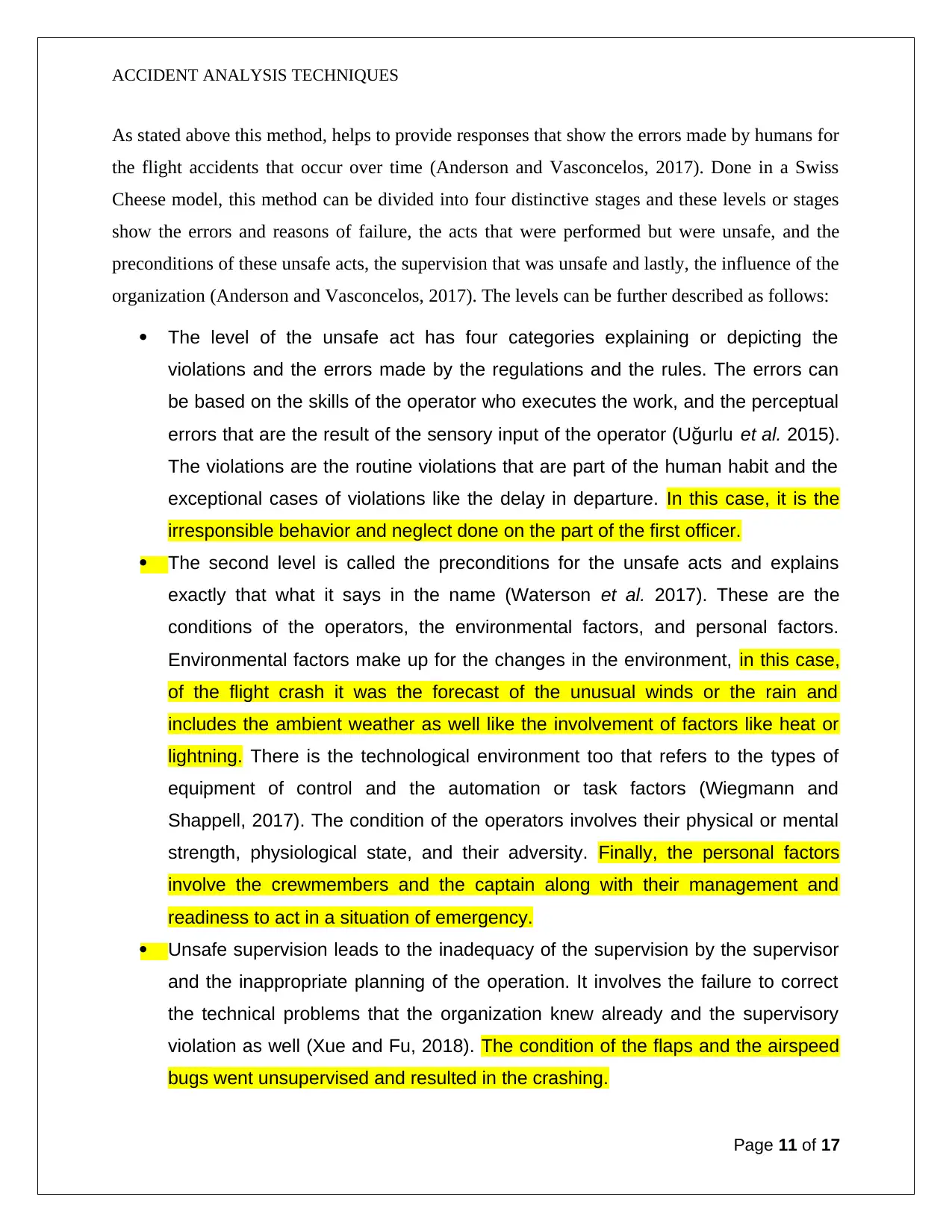
ACCIDENT ANALYSIS TECHNIQUES
As stated above this method, helps to provide responses that show the errors made by humans for
the flight accidents that occur over time (Anderson and Vasconcelos, 2017). Done in a Swiss
Cheese model, this method can be divided into four distinctive stages and these levels or stages
show the errors and reasons of failure, the acts that were performed but were unsafe, and the
preconditions of these unsafe acts, the supervision that was unsafe and lastly, the influence of the
organization (Anderson and Vasconcelos, 2017). The levels can be further described as follows:
The level of the unsafe act has four categories explaining or depicting the
violations and the errors made by the regulations and the rules. The errors can
be based on the skills of the operator who executes the work, and the perceptual
errors that are the result of the sensory input of the operator (Uğurlu et al. 2015).
The violations are the routine violations that are part of the human habit and the
exceptional cases of violations like the delay in departure. In this case, it is the
irresponsible behavior and neglect done on the part of the first officer.
The second level is called the preconditions for the unsafe acts and explains
exactly that what it says in the name (Waterson et al. 2017). These are the
conditions of the operators, the environmental factors, and personal factors.
Environmental factors make up for the changes in the environment, in this case,
of the flight crash it was the forecast of the unusual winds or the rain and
includes the ambient weather as well like the involvement of factors like heat or
lightning. There is the technological environment too that refers to the types of
equipment of control and the automation or task factors (Wiegmann and
Shappell, 2017). The condition of the operators involves their physical or mental
strength, physiological state, and their adversity. Finally, the personal factors
involve the crewmembers and the captain along with their management and
readiness to act in a situation of emergency.
Unsafe supervision leads to the inadequacy of the supervision by the supervisor
and the inappropriate planning of the operation. It involves the failure to correct
the technical problems that the organization knew already and the supervisory
violation as well (Xue and Fu, 2018). The condition of the flaps and the airspeed
bugs went unsupervised and resulted in the crashing.
Page 11 of 17
As stated above this method, helps to provide responses that show the errors made by humans for
the flight accidents that occur over time (Anderson and Vasconcelos, 2017). Done in a Swiss
Cheese model, this method can be divided into four distinctive stages and these levels or stages
show the errors and reasons of failure, the acts that were performed but were unsafe, and the
preconditions of these unsafe acts, the supervision that was unsafe and lastly, the influence of the
organization (Anderson and Vasconcelos, 2017). The levels can be further described as follows:
The level of the unsafe act has four categories explaining or depicting the
violations and the errors made by the regulations and the rules. The errors can
be based on the skills of the operator who executes the work, and the perceptual
errors that are the result of the sensory input of the operator (Uğurlu et al. 2015).
The violations are the routine violations that are part of the human habit and the
exceptional cases of violations like the delay in departure. In this case, it is the
irresponsible behavior and neglect done on the part of the first officer.
The second level is called the preconditions for the unsafe acts and explains
exactly that what it says in the name (Waterson et al. 2017). These are the
conditions of the operators, the environmental factors, and personal factors.
Environmental factors make up for the changes in the environment, in this case,
of the flight crash it was the forecast of the unusual winds or the rain and
includes the ambient weather as well like the involvement of factors like heat or
lightning. There is the technological environment too that refers to the types of
equipment of control and the automation or task factors (Wiegmann and
Shappell, 2017). The condition of the operators involves their physical or mental
strength, physiological state, and their adversity. Finally, the personal factors
involve the crewmembers and the captain along with their management and
readiness to act in a situation of emergency.
Unsafe supervision leads to the inadequacy of the supervision by the supervisor
and the inappropriate planning of the operation. It involves the failure to correct
the technical problems that the organization knew already and the supervisory
violation as well (Xue and Fu, 2018). The condition of the flaps and the airspeed
bugs went unsupervised and resulted in the crashing.
Page 11 of 17
⊘ This is a preview!⊘
Do you want full access?
Subscribe today to unlock all pages.

Trusted by 1+ million students worldwide
1 out of 17
Your All-in-One AI-Powered Toolkit for Academic Success.
+13062052269
info@desklib.com
Available 24*7 on WhatsApp / Email
![[object Object]](/_next/static/media/star-bottom.7253800d.svg)
Unlock your academic potential
Copyright © 2020–2025 A2Z Services. All Rights Reserved. Developed and managed by ZUCOL.